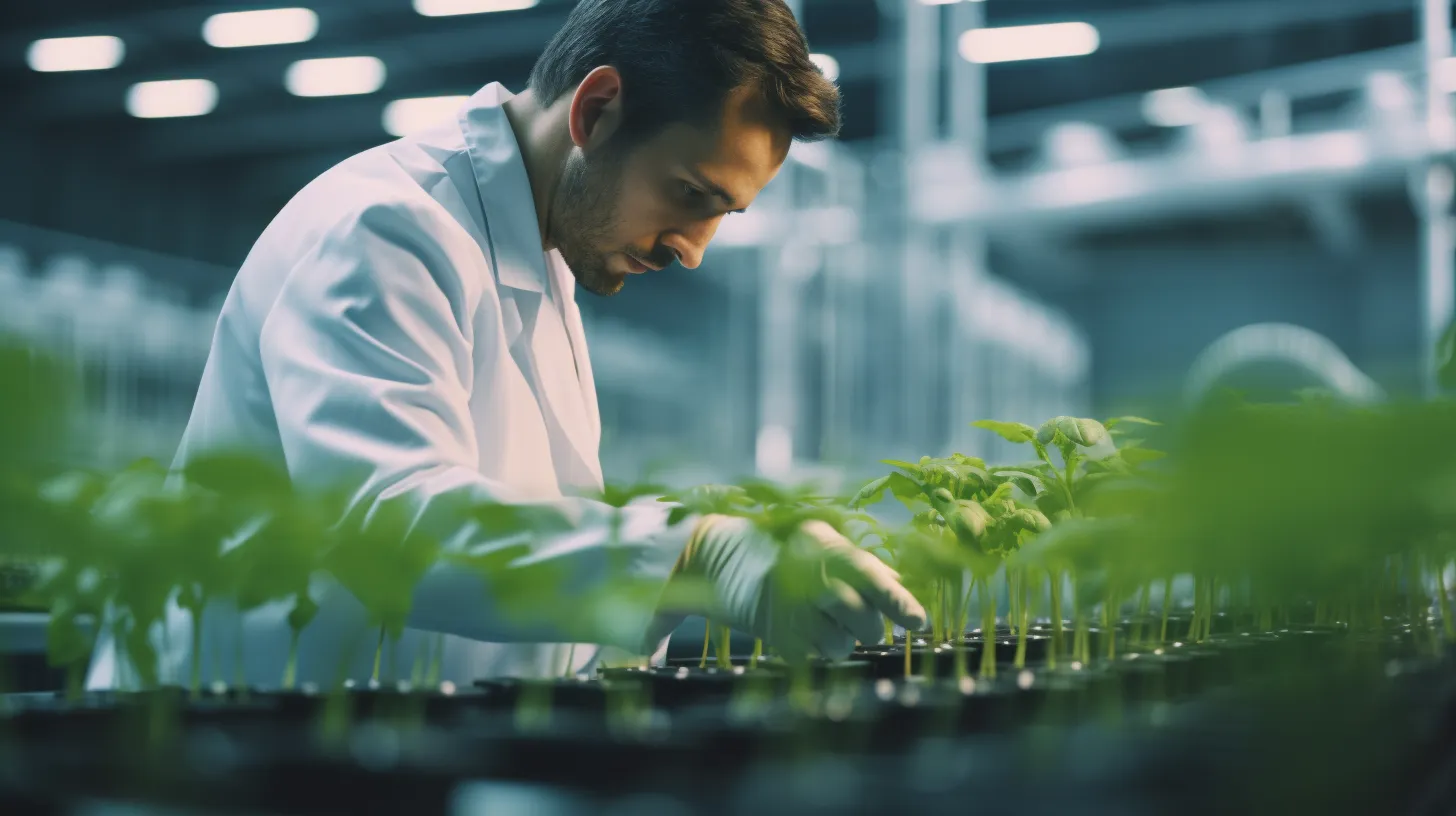Often overlooked, the soil beneath our feet is the foundation of life on Earth. It is a bustling blend of biodiversity full of microorganisms that play a critical role in the planet’s health. One of the most exciting advancements in soil science is the emergence of soil genomics. This field of study delves into the genetic material of soil’s microbial inhabitants, offering unprecedented insights into the soil ecosystem.
This article explores how soil genomics unlocks the secrets of the soil, paving the way for sustainable agriculture and environmental conservation.

Understanding Soil Genomics
Now, the first question that comes in is – What is Soil Genomics? Soil genomics is a field that applies genomic techniques to study the soil’s biological community. Unlike traditional soil analysis techniques focusing on physical and chemical properties, soil genomics dives into the genetic makeup of soil microorganisms. It provides a deeper understanding of the soil’s biological health, revealing the intricate web of life beneath the surface.
Soil genomics encompasses various techniques, including DNA extraction, sequencing, and bioinformatics. DNA extraction involves isolating DNA from soil samples sequenced to identify the types of microorganisms present.
The Hidden World of Soil Microorganisms
The soil, a living and breathing entity, is home to a vast diversity of microorganisms, including bacteria, fungi, viruses, and archaea. These microscopic inhabitants form a complex network known as the soil microbiome. Each microbe plays a unique role, contributing to the soil’s overall health and fertility.
Soil microorganisms are the unsung heroes of the soil ecosystem. They drive essential processes such as nutrient cycling and decomposition, breaking organic matter into nutrients that plants can absorb. They also contribute to the soil’s structure, enhancing its capacity to retain water and resist erosion.
Soil Genomics Techniques
As we journey into the microscopic universe of soil, let’s unravel several transformative techniques central to soil genomics, illuminating the mysteries of this subterranean ecosystem and its myriad inhabitants, each playing a crucial role in shaping the health, fertility, and sustainability of our planet’s soils.
DNA Sequencing: Decoding the Soil Microbiome
DNA sequencing technologies have revolutionized soil genomics. Techniques such as Next-Generation Sequencing (NGS) allow for rapid sequencing of the DNA of thousands of different organisms in a soil sample. This provides a snapshot of the microbial community’s composition, revealing which species are present and their relative abundances. RhizeBio’s DNA Sequencing for Soil is at the forefront of these technologies.
Meta-omics: Unveiling the Functional Potential of Soil Microbes
While DNA sequencing reveals who is present in the soil, it doesn’t tell us what these microbes are doing. This is where metagenomics, metatranscriptomics, and metaproteomics come in. These techniques made from RhizeBio’s Soil Analytics Systems provide insights into the functional potential of the soil microbiome, revealing the biochemical processes that the microbes are carrying out.
Bioinformatics: Making Sense of the Data
The vast amount of data generated by these techniques require sophisticated bioinformatic tools for analysis. These tools help researchers assemble and annotate genomes, identify genes and their functions, and compare microbial communities across different soil samples. For instance, RhizeBio’s Soil Data Science Innovations can help predict how these communities might respond to changes in environmental conditions, providing valuable insights for soil management and conservation.

Applications of Soil Genomics
Venturing into the intricate world beneath our feet, we delve into the myriad applications of soil genomics, an emerging field that deciphers the genetic information of the soil, unlocking secrets about the microbial communities that thrive there and their profound influence on both agriculture and the broader environment.
Unraveling Microbial Diversity and Interactions
Soil genomics has the power to unravel the complex web of microbial diversity and interactions in the soil. By studying the genetic material of soil microbes, we can identify novel genes and functional traits. For example, RhizeBio’s Soil Biology Enhancements stand tall as a key player in discovering the soil’s biological health and its potential to support plant growth.
Moreover, soil genomics can help us understand the intricate relationships between different microbes. You can check these microbial interactions with RhizeBio’s Comprehensive Soil Testing. For instance, some microbes form symbiotic relationships, helping each other survive in the harsh soil environment. Others might compete for resources or even produce substances that inhibit the growth of their competitors. Understanding these interactions can help us manage the soil microbiome to promote beneficial microbes and suppress harmful ones.
Identifying Novel Genes and Functional Traits
Soil genomics can also help identify novel genes and functional traits with potential agricultural and environmental applications. For example, genes involved in nutrient cycling or decomposition could be harnessed to improve soil fertility or manage waste.
Additionally, soil genomics can help us discover new enzymes produced by soil microbes. These enzymes, which help the microbes break down organic matter, could have industrial applications. For instance, they could be used to break down waste materials or produce biofuels.
Understanding the Impact of Environmental Factors
Soil genomics can also shed light on how environmental factors, such as climate change or pollution, impact soil microbial communities. This knowledge tested with RhizeBio’s Soil Health Risk Management tools can inform strategies to mitigate these impacts, promoting soil health and resilience.
For example, soil genomics can help us understand how soil microbes respond to changes in temperature, moisture, or nutrient availability. This can help us predict how climate change might impact soil health and develop strategies to adapt to these changes.
Soil Genomics and Agriculture
-
Improving Soil Fertility and Nutrient Management
Soil genomics has significant implications for agriculture. By providing insights into the soil’s microbial community and its functions, soil genomics can inform strategies to improve soil fertility and nutrient management. This can lead to increased crop yields and sustainability.
In addition, soil genomics can help us understand how different farming practices impact the soil microbiome.
For instance, it can help us compare the effects of conventional farming practices, such as the use of synthetic fertilizers and pesticides, with those of organic farming practices. This knowledge can guide the development of farming practices that promote a healthy soil microbiome, leading to more sustainable agriculture.
-
Harnessing Beneficial Microbial Traits
Soil genomics can also help harness beneficial microbial traits for sustainable agriculture. For example, you can use biological trial systems to discover the microbes that promote plant growth or suppress plant diseases and how they could be used to develop microbial-based biofertilizers and biostimulants.
Furthermore, this field can help us understand how these beneficial microbes interact with plants. Certainly, some microbes form symbiotic relationships with plants. Now, this relationship will help them absorb nutrients from the soil. Others might produce substances that protect plants from pests or diseases. Understanding these interactions can help us develop more effective biofertilizers and biostimulants.
-
Developing Microbial-Based Biofertilizers and Biostimulants
Harnessing the power of soil genomics, we can develop microbial-based biofertilizers and biostimulants that can revolutionize sustainable farming practices. These products utilize beneficial soil microbes, such as nitrogen-fixing bacteria or mycorrhizal fungi, to enhance plant growth and health. They can improve nutrient uptake, boost plant immunity, and increase crop yields, all while reducing the need for synthetic fertilizers and pesticides.

Soil Genomics and Environmental Conservation
-
Soil Remediation and Pollution Management
Soil genomics can play a crucial role in soil remediation and pollution management. By identifying microbes that can degrade pollutants or stabilize heavy metals, soil genomics can inform strategies to clean up contaminated soils and prevent further pollution.
Additionally, you can understand how pollution impacts the soil microbiome. For instance, it can help us know how different pollutants, such as heavy metals or pesticides, affect the diversity and function of soil microbes. This knowledge can inform strategies to mitigate the impacts of pollution and restore soil health.
-
Restoring Degraded Soils and Promoting Ecosystem Resilience
Soil degradation, a global issue, threatens food security and biodiversity. Soil genomics can be pivotal in restoring degraded soils and promoting ecosystem resilience. Understanding the soil’s microbial community can reintroduce beneficial microbes and practices that enhance soil health and function. Techniques like cover cropping, composting, and no-till farming can help rebuild soil structure and fertility.
RhizeBio’s Soil Health Management Systems and Soil Remediation Techniques are instrumental in this restoration process. They provide insights into the soil’s biological health, guiding the implementation of regenerative practices. This not only restores degraded soils but also builds resilience against future environmental stresses, ensuring a sustainable future for our ecosystems.
-
Climate Change Mitigation and Adaptation
Soil genomics can significantly contribute to climate change mitigation and adaptation strategies. Soil microorganisms are crucial in carbon sequestration, where CO2 is captured from the atmosphere and stored in the soil. By understanding and managing these microbial communities, we can enhance the soil’s capacity to sequester carbon, helping to mitigate climate change.
Moreover, soil genomics can help us develop adaptation strategies. For instance, identifying microbes that help plants withstand drought or extreme temperatures can be crucial in breeding climate-resilient crops.
Soil Genomics and Human Health
-
Examining the Potential Impacts of Soil Microorganisms on Human Health
Soil has a profound effect on human health, with the potential for both positive and negative impacts. Soil is a significant source of nutrients in our food supply and medicines such as antibiotics. However, imbalances in nutrients and the existence of human pathogens within the soil’s biological community can lead to adverse health effects. Additionally, there are numerous areas where elements of chemical compounds are present in the soil at levels that are toxic due to either natural circumstances or human activities.
The soil of urban environments has received increased attention in recent years, posing a number of human health questions and challenges. Concepts such as soil security may provide a framework within which soil and human health issues can be investigated using interdisciplinary and transdisciplinary approaches.
-
Identifying Beneficial Microbes for Biopharmaceutical and Biotechnological Applications
Soil genomics can also help identify beneficial microbes for bio-pharmaceutical and biotechnological applications. For example, microbes that produce enzymes or other useful compounds could be harnessed for industrial processes. RhizeBio’s Technology is instrumental in this field.
-
Investigating Soil Genomics for Potential Therapeutic Use and Disease Prevention
Just as our overreliance on antibiotics and highly processed foods has inadvertently destroyed crucial microbes in the human gut, our reckless use of certain chemical fertilizers, fungicides, herbicides, pesticides, insufficient addition of organic matter (which they feed on), and intensive tillage has devastated essential soil microbiota crucial to plant health. These soil microorganisms, especially bacteria and fungi, cycle nutrients and water to plants, our crops, which are the source of our food and, ultimately, our health.
Soil bacteria and fungi act as the “digestive system” of plants. They establish symbiotic relationships with plant roots and “break down” nutrients, providing nitrogen, phosphorus, and numerous other nutrients in a form that plant cells can absorb. Reintroducing the appropriate bacteria and fungi to stimulate the dark fermentation process in depleted and sterile soils is akin to consuming yogurt (or taking those specific probiotic “medicines of the future”) to restore the correct microbiota deep within your digestive system.

Challenges and Limitations
-
Addressing the Complexity of Soil Genomic Data
Soil genomic data is incredibly complex, reflecting immense diversity and intricate interactions of soil microorganisms. Analyzing this data requires sophisticated bioinformatics tools and a deep understanding of genomics and soil ecology.
Moreover, soil genomic data is often “noisy” due to extraneous DNA and the sheer number of different organisms. Addressing this complexity to extract meaningful insights is a significant challenge, requiring ongoing advancements in data analysis techniques and computational capacities.
-
Integrating Soil Genomics into Existing Soil Management Practices
Integrating soil genomics into existing soil management practices is a significant challenge. Traditional soil management has relied on observable and measurable physical and chemical properties of soil. However, soil genomics delves into the microscopic and molecular level, requiring a paradigm shift in understanding and managing soil. Farmers and soil managers may lack the technical knowledge to interpret and apply genomic data.
Moreover, the infrastructure for large-scale genomic testing and monitoring is still under development. Bridging this gap requires not only advancements in technology but also extensive training and education programs to equip practitioners with the necessary skills and understanding. Despite these hurdles, the potential of soil genomics to revolutionize soil management practices is immense, promising more sustainable and productive agricultural systems.
-
Ethical Considerations in Soil Genomic Research
Soil genomic research also raises several ethical considerations. For instance, the collection and use of soil samples may involve issues of access and benefit-sharing, particularly when samples are taken from lands owned or managed by Indigenous peoples or local communities.
There are also concerns about the potential misuse of soil genomic data, such as developing biological weapons or patenting naturally occurring genetic resources. Addressing these ethical considerations requires clear guidelines and regulations, as well as an ongoing dialogue with stakeholders and the public.
Future Perspectives
-
Advancements in Soil Genomic Technologies
The future of soil genomics is closely tied to advancements in genomic technologies. As sequencing technologies become more affordable and accessible, we can expect a surge in soil genomic research.
Developments in bioinformatics and machine learning will also enhance our ability to analyze and interpret complex genomic data, leading to more accurate and detailed insights into the soil microbiome. These advancements will open up new avenues for understanding and managing soil health.
-
Collaboration and Interdisciplinary Research
The complexity of soil ecosystems necessitates collaboration and interdisciplinary research. Soil genomics sits at the intersection of various fields, including microbiology, ecology, agronomy, and computer science.
We can gain a more holistic understanding of soil ecosystems by fostering collaboration between these disciplines. This interdisciplinary approach will also facilitate translating genomic research into practical applications for soil management and conservation.

-
The Role of Soil Genomics in Shaping Sustainable Agriculture and Environmental Conservation
Soil genomics has the potential to play a pivotal role in shaping sustainable agriculture and environmental conservation. It can guide the development of more effective and sustainable soil management practices by providing insights into the soil microbiome.
These include using microbial biofertilizers, precision farming techniques, and strategies for enhancing soil carbon sequestration. As we face the challenges of climate change and soil degradation, soil genomics will be an invaluable tool in our efforts to promote a more sustainable and resilient future.
Conclusion
In conclusion, soil genomics is a powerful tool for unlocking the secrets of the soil. By delving into the genetic makeup of soil microbes, soil genomics provides unprecedented insights into the soil ecosystem, paving the way for sustainable agriculture and environmental conservation. While we continue to explore the hidden world of soil microorganisms, we can look forward to a future where soil health is at the heart of our efforts to feed the world and protect the planet.
